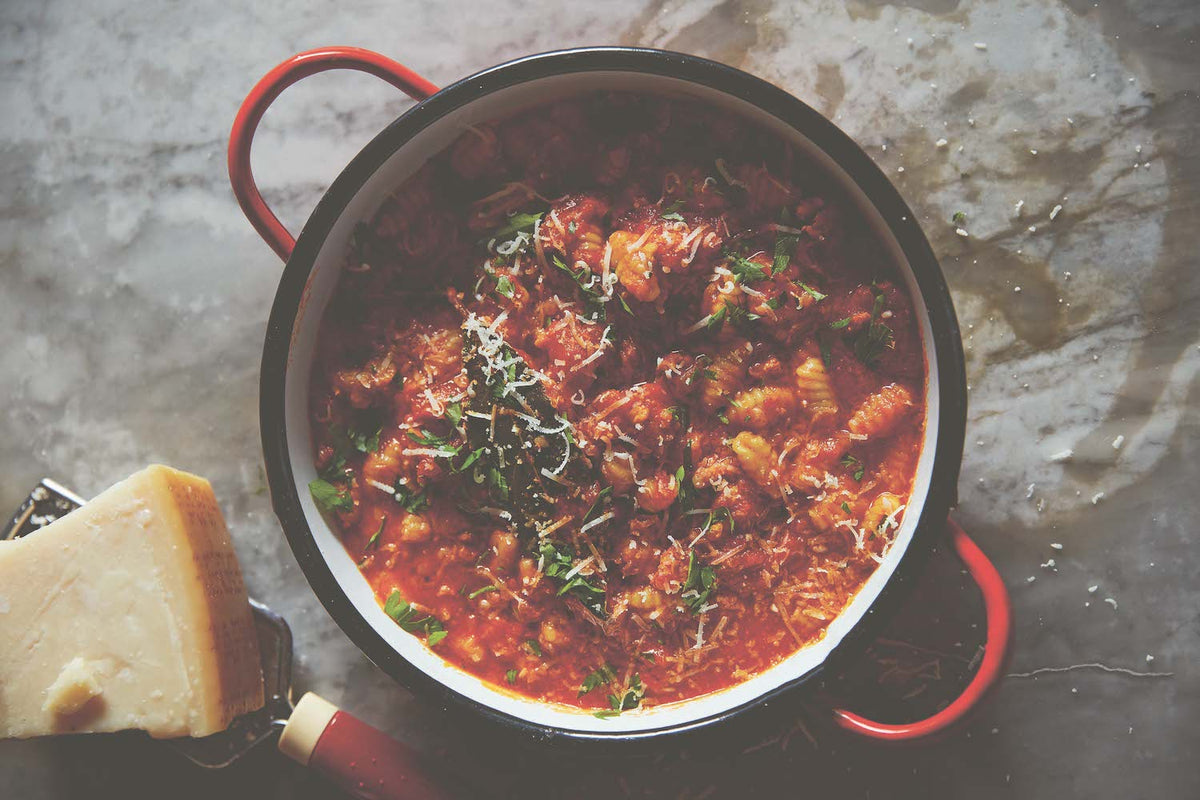
Malloreddus with Sardinian Sausage Ragù
|
|
Time to read 3 min
|
|
Time to read 3 min
This is one of Sardinia’s most iconic dishes. Malloreddus are small, ridged pasta nuggets, still made by hand in many parts of Sardinia, and known also as Sardinian gnocchi.
They are made with a simple two parts semolina, one part water mix. It is traditional to add a pinch of saffron to give the dough a beautiful yellow hue, as though it had been made with good eggs; a tradition inherited from a time when eggs were more expensive in Sardinia than saffron.
These are so easy to make it will banish any fear of making pasta at home that you have ever had, and the fact that they require nothing fresh, only some flour forgotten at the back of the cupboard, and water from a tap, makes them a brilliant fall-back for an empty fridge. The dough is pliable and forgiving to work with, and even better, you do not need a pasta machine.
The traditional shape of the malloreddus is formed by rolling one side of the nuggets along a Sardinian wicker basket, though many now use a gnocchi board. If you cannot find either, then the tines of a fork will do fine. The ridges are necessary and important as they are designed to catch and trap the thick sauce.
The sauce is named after the large plain of Campidano, and is the Sardinian equivalent of the beloved Bolognese ragù. Like all good ragùs, it is satisfying, savoury and rich. Fat is flavour, and here the depth of the sauce is provided by a good, fatty sausage. The tomatoes cook slowly into sweet and slippery submission, whilst the saffron and chilli provide welcome notes of heat and spice.
I am not, as a rule, a great fan of sausages. I rarely cook them. Mostly because I find lots of them pale, flabby and flavourless. A good sausage should be almost the same colour as salami, dark and rich and visibly composed of chunks of real meat and fat, in equal proportions.
In Sardinia, the sausages are generally much meatier. Try to find the best sausages you can – really, properly meaty and fatty at the same time. Toulouse or Tuscan are good options.

90 minutes
50 minutes
6
2 cups (300 grams) fine semolina ( semolina rimacinata ), plus extra for dusting
²⁄₃ cup (150 grams) lukewarm water
pinch of sea salt
pinch of saffron powder
1 large white onion, diced
2 garlic cloves, sliced
4 tablespoons olive oil
4 fresh bay leaves
1 small dried chili
pinch of saffron powder
10½ ounces (300 grams) sausage meat
28 ounces (800 grams) tins tomatoes
scant ½ cup (100 milliliters) white wine, ideally Vernaccia
sea salt
5¼ ounces (150 grams) pecorino, grated, plus extra to serve
parsley, finely chopped
Mix all the ingredients together and work (either with your hands or in an electric mixer) until you have a nice smooth dough. Leave to rest under a cloth for 30 minutes – I usually use the time to clear up.
Cut the dough into five even pieces and roll them into long sausages around ½ inch (1 cm) width, then cut each piece of dough into ½ in- (1 cm-) square nuggets. If things are getting soft or sticky, add more semolina.
Take each little nugget and press it down in the middle and roll it down the back of a fork, or on your gnocchi board . Place on a tray sprinkled with semolina.
At this point, you can use them straight away or they can be kept in the fridge for a day or two, or frozen for up to a month. If you wish to, you can dry them out completely in the sun or in a very low oven then store in an airtight container indefinitely.
To make the sauce, cook the onion and garlic in the oil in a wide, deep pan over a medium heat until soft and beginning to brown, around 10 minutes. Add the bay leaf, chilli, saffron, sausage meat, making sure to break it up into small pieces.
Continue to fry and stir over a medium heat until the sausage is cooked and golden. Add the tomatoes, wine and a small splash of water, and leave to simmer for at least 40 minutes. Keep stirring whenever you think of it and continue mushing up the sausage with your spoon. Taste and check for seasoning.
Bring another pan of water to the boil and salt well. Tip in your malloreddus and cook for 1–2 minutes, until they bob to the surface. Ladle out and place in the hot sauce with a small ladle of pasta cooking water. Add the grated pecorino and stir gently, turning all of the nuggets over in their sauce. Continue to cook for another minute or so until the sauce turns silky.
Spoon into shallow bowls and serve with more grated pecorino, if you wish, and parsley.